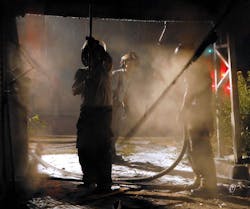Say it isn't true, but are we all truckies on the inside? As I fight the urge to become something that this jumpseat rider would never could have imagined, it might be coming true. We all have a truck firefighter inside us. As a proud engine firefighter for 20 years I guess truck company functions are skills that all well-rounded firefighters must have. From small town firefighters to big city truck company firefighters we must all have good search, overhaul, and laddering skills.
One lesson all firefighters should know is not to pull the ceiling directly over your head. Learning this lesson the hard way can lead to insults by peers and, even worse, a trip to the hospital. Pulling ceilings is an art form performed by skilled firefighters that use their hooks like an artist uses their brushes. Let’s take a look into hooking, hooking jumpseat style.
Plaster Ceilings
In older homes the plaster ceilings can make the tough job seemed impossible. Creating a point to start pulling from can be hard, to say the least. Finding the “sweet spot” to start pulling from inside a smoke filled environment can be challenging. A good rule of thumb is to avoid light fixtures, fans, and exterior walls. Finding a space between ceiling fixtures and interior walls can make it somewhat easier to create the first hole. Once the inspection hole has been made you can establish the roof support layout.
How do you make this assessment inside smoke filled environments? One way of establishing the starting point is to use the furniture layout to determine walkways and room layouts. Hooking in the walkways can help start the process, even in low visibility situations.
Drywall Ceilings
This type of construction can make pulling easier, compared to plaster ceilings. Initial inspection holes and pulling will be faster and require less effort by the firefighter. The big challenge with drywall ceilings is the danger it poses after becoming saturated with water. Once soaked, it can come down in four- to eight-foot sections providing a huge danger for the hooking firefighter that can’t get away from the falling ceiling. This danger is increased with commercial and multi-family dwellings that require thicker drywall to meet code.
Double Layer
The real challenge comes when the drywall is placed over plaster ceilings. While not common, many people will save the time and effort by screwing the drywall over the top of plaster. Doing this allows construction to be quicker and makes finishing the walls easier. Having these two layers can keep the fire hidden longer in attic spaces and provide a challenge to firefighters trying to open up the ceilings to extinguish fire or start the overhaul process. Making the initial hole can prove to be the worst part of this procedure. Using your crew to double up on the hook can help make the initial point of entry. Once the first hole is made using a proper angle to pull is paramount to keep falling debris off us.
Don’t Hook Over Your Head
Seems like pulling ceilings shouldn’t even be covered in a blog post, but you know it must have happened to inspire 800 words of education. So I must admit, it happened to this jumpseat rider. No injuries happened because of a well placed helmet and a little bit of luck. It was a "duh" moment for sure. All of us have them, we just need to ensure that we learn from them. The lesson learned from this moment is not to stand underneath the ceiling as it is being pulled. Using some of the tips mentioned above can help keep you out of the danger zone at your next fire. The next time you walk into a home take a look up to size-up what type of ceiling construction you have and how you would orient yourself to begin the overhaul procedures.
Bunker up, buckle in, it’s where we all begin…
See Ryan Pennington as he presents "EMS Response in Hoarder Homes" at Firehouse Wold in San Diego, Feb. 17-20.






